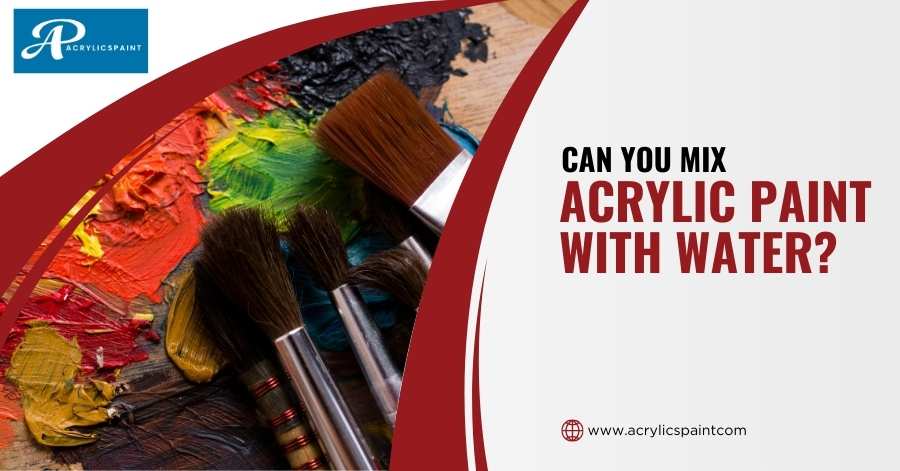Can you mix acrylic paint with water? Acrylic paints are versatile mediums artists love for their vibrant colours, fast drying time, and ability to work on various surfaces. But a common question for beginners and seasoned artists alike is: Can you mix acrylic paint with water? The answer is a resounding yes, and understanding how to effectively combine these elements unlocks a whole new world of creative possibilities in your acrylic paintings.
Understanding Can you mix acrylic paint with water?
Acrylic paint is a water-based medium with pigments suspended in an acrylic polymer emulsion. This composition makes acrylic paint water-soluble, allowing artists to manipulate its consistency with water.
So, can you mix water with acrylic paint? Absolutely! Water can be added to acrylic paint to achieve various effects, from thinning the paint for translucent layers to creating fluid pour paintings.
Why Mix Acrylics with Water?
You may mix acrylic paint with water for several reasons. The primary benefit is to thin the paint, making it flow more easily. This is particularly useful for achieving techniques like washes, glazes, and fine details. Here’s a breakdown of some key benefits:
- Achieving Transparency: Adding water creates a thinner consistency, allowing light to pass through the paint layers. This results in a more transparent effect, mimicking the look of watercolours.
- Creating Washes and Glazes: Thinned-down acrylics are perfect for creating washes, which are thin, transparent layers of colour used to establish a base tone or add subtle variations. Conversely, glazes build up colour slowly and create depth without obscuring the layers beneath.
- Detailed Work: Watered-down paints allow for finer brushstrokes and intricate details. This is ideal for hair-thin lines, creating textures, and adding realistic highlights.
- Pour Painting: The pouring technique uses fluid consistency to create dynamic and abstract art. By mixing acrylics with water (and sometimes pouring mediums), artists can achieve the desired flow so that their paint moves freely across the canvas.
However, it’s important to remember that there’s a balance. Adding too much water can weaken the binding properties of acrylics, impacting durability and adhesion.
Can you mix water with acrylic paint and pour it?
Pour painting has gained popularity in recent years for its mesmerizing results. Fortunately, acrylic paint is ideal for this technique. Mixing water with acrylic paint allows you to adjust the viscosity to achieve the desired fluidity for pouring. Experimenting with different ratios of water to paint will help you achieve the best consistency for your pouring projects.
Can You Mix Acrylic Paint with Water to Make Watercolor?
Yes, you can! Adding more water to acrylic paint creates a watercolour-like consistency, allowing you to achieve delicate washes and transparent layers similar to traditional watercolour painting. This makes acrylic paint a favourite among artists who enjoy the flexibility of working with both opaque and translucent effects.
Mixing Acrylic Paint with Other Media
Acrylic paint can also be mixed with other water-based mediums, such as oil paint or sealers. While experimentation is vital, mixing acrylic paint with these mediums can yield exciting results, expanding your creative possibilities.
Using Water with Acrylic Paint for Walls
Adding water can help improve the paint’s flow and coverage when painting walls with acrylic paint. However, following the instructions and using the appropriate amount of water is essential to avoid compromising the paint’s durability and adhesion.
Do Acrylic Paints Need Water?
While water is not required for acrylic paint to function, it can be used to modify its consistency and achieve specific effects. Whether thinning the paint for glazing or creating fluid washes, water can be a valuable tool in your acrylic painting arsenal.
Mixing Techniques: Finding the Perfect Balance
Now that we know the benefits let’s explore some techniques for mixing acrylics with water:
The Ratio Game
There’s no one-size-fits-all answer to the water-to-paint ratio. It depends on the desired effect. For washes and glazes, a good starting point is a 1:1 ratio (one part water to one part paint).
For thinner washes, you can increase the water content. Remember, experiment on a scrap surface to find your ideal consistency.
Wet on Wet
This technique involves applying thinned paint onto a damp surface, allowing the colours to blend and create soft transitions. It’s perfect for creating dreamy landscapes or ethereal effects.
Layering
Once a layer dries, apply watered-down acrylics on top for glazes or washes. This allows for gradually building colour depth.
Tips for Mixing Acrylic Paint with Water
- Start with a small amount of water and gradually add more to achieve the desired consistency.
- Use distilled water to prevent impurities from affecting the paint’s performance.
- Experiment with different ratios of water to paint to discover your desired effects.
- Remember that adding too much water can affect the paint’s adhesion and durability, so use water sparingly, especially when painting on surfaces that require longevity.
Things to Consider When Mixing with Water
While water is a readily available and effective thinner, here are some additional points to keep in mind:
- Acrylics vs. Watercolors: Although adding water makes acrylics more transparent, they won’t behave exactly like watercolors. Acrylics dry to a water-resistant film, while watercolours remain water-soluble.
- Water-Based vs. Water-Mixable Oil Paints: Do not mix acrylics with traditional or water-mixable oil paints. These mediums have different drying times and chemical compositions, leading to potentially harmful results.
- Acrylic Water-Based Sealers: Generally, mixing acrylics with water-based sealers is safe. However, always test a small amount first to ensure it’s safe and avoid unwanted interactions.
- Acrylic Painting on Walls: While acrylics are often used on walls, using them directly with water isn’t recommended. Walls are porous and require a proper primer to ensure adhesion. Opt for pre-mixed acrylic wall paints for this purpose.
Thinning Alternatives
While water is a great starting point, there are other acrylic thinning mediums available:
Acrylic Thinning Mediums
These mediums are specifically formulated to thin acrylic paint while minimizing the drawbacks of using water. They often enhance flow while maintaining the paint’s binding properties and flexibility.
Gels and Pastes
Acrylic gels and pastes can be mixed with water to create various consistencies. They offer additional benefits, such as texture and increased working time.
Conclusion
In conclusion, mixing acrylic paint with water opens many possibilities for artists. Whether you’re creating fluid pour paintings, translucent washes, or simply adjusting the consistency of your paint for various techniques, water can be a valuable tool in your acrylic painting toolkit. So, the next time you ask, “Can you mix acrylic paint with water?” and Can You Mix oil and acrylic paint? Remember, yes, you can unlock endless creative potential with some experimentation.













